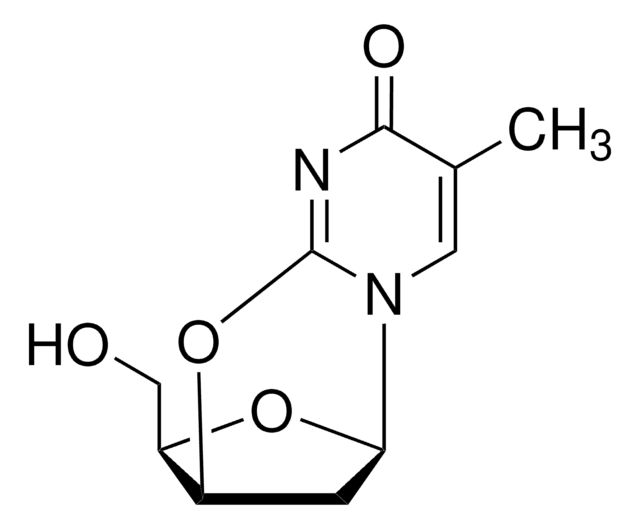A6007
Apotryptophanase from Escherichia coli
soluble powder, 75-150 units/mg solid
Synonym(s):
Tryptophanase from Escherichia coli, L-Tryptophan indole-lyase (deaminating)
Sign Into View Organizational & Contract Pricing
All Photos(2)
About This Item
CAS Number:
MDL number:
UNSPSC Code:
12352204
NACRES:
NA.54
Recommended Products
biological source
Escherichia coli
Quality Level
form
soluble powder
specific activity
75-150 units/mg solid
storage temp.
−20°C
Looking for similar products? Visit Product Comparison Guide
Application
Apotryptophanase is used for the quantitative determination of pyridoxal-phosphate. Apotryptophanase, from Sigma, has been used to study pregnancy-associated PLP deficiency and vitamin B-6 deficiency .
Biochem/physiol Actions
Apotryptophanase hydrolizes tryptophan and is capable of catalyzing α,β-elimination reactions with a number of substituted amino acids, including S-methyl-, S-ethyl- and S-benzyl- L-cysteine. DTNB inactivates tryptophanase .
Unit Definition
One unit releases one μg of indole from L-tryptophan in 10 min at pH 8.3 at 37 °C in the presence of 0.04 mM pyridoxal-5′--phosphate.
Storage Class Code
11 - Combustible Solids
WGK
WGK 3
Flash Point(F)
Not applicable
Flash Point(C)
Not applicable
Personal Protective Equipment
dust mask type N95 (US), Eyeshields, Gloves
Certificates of Analysis (COA)
Search for Certificates of Analysis (COA) by entering the products Lot/Batch Number. Lot and Batch Numbers can be found on a product’s label following the words ‘Lot’ or ‘Batch’.
Already Own This Product?
Find documentation for the products that you have recently purchased in the Document Library.
Christian Starkenmann et al.
Journal of agricultural and food chemistry, 59(7), 3358-3365 (2011-03-08)
The objective of this study was to verify whether the volatile organic sulfur compounds recently discovered in bell pepper (Capsicum annuum, L. cultivars), such as the mercapto-ketones: 4-sulfanyl-2-heptanone and 2-sulfanyl-4-heptanone, the mercapto-alcohols: 4-sulfanyl-2-heptanol and 2-sulfanyl-4-heptanol, and heptane-2,4-dithiol, originate from their
Dorota Kuczyńska-Wiśnik et al.
Research in microbiology, 161(10), 847-853 (2010-09-28)
Recent studies have revealed that antibiotics can promote the formation of reactive oxygen species which contribute to cell death. In this study, we report that five different antibiotics known to stimulate production of reactive oxygen species inhibited growth of Escherichia
Leonardo G Trabuco et al.
Structure (London, England : 1993), 18(5), 627-637 (2010-05-14)
Regulatory nascent chains interact with the ribosomal exit tunnel and modulate their own translation. To characterize nascent chain recognition by the ribosome at the atomic level, extensive molecular dynamics simulations of TnaC, the leader peptide of the tryptophanase operon, inside
Biochemistry. Nascent proteins caught in the act.
Martin Kampmann et al.
Science (New York, N.Y.), 326(5958), 1352-1353 (2009-12-08)
Zhi-Jun Zhao et al.
Journal of industrial microbiology & biotechnology, 38(12), 1921-1929 (2011-05-05)
Construction and improvement of industrial strains play a central role in the commercial development of microbial fermentation processes. L-tryptophan producers have usually been developed by classical random mutagenesis due to its complicated metabolic network and regulatory mechanism. However, in the
Our team of scientists has experience in all areas of research including Life Science, Material Science, Chemical Synthesis, Chromatography, Analytical and many others.
Contact Technical Service








